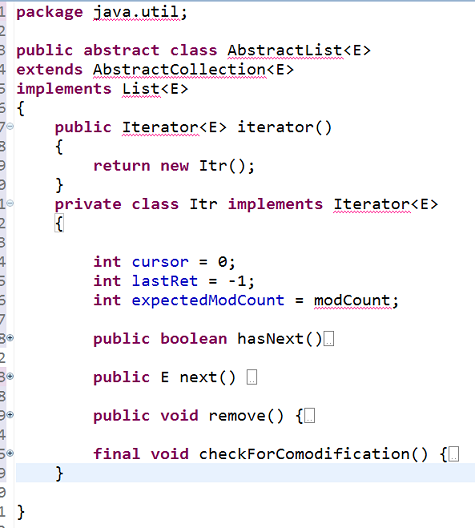1,完整代码
//创建两个arraylist对象
Collection al = new ArrayList();
//al1添加元素
al.add("name1");
al.add("name4");
al.add("name3");
Iterator it=al.iterator();
while(it.hasNext())
{
System.out.println(it.next());
}
for循环的实现
for(Iterator it=al.iterator();it.hasNext();) { System.out.println(it.next()); }
for()的好处:更节约内存
Iterator定义在了循环内部,在循环结束后,it就被释放了,
而在While中it定义在了循环外面,循环结束后对象依然存在,但是却没什么用处,就造成了内存的浪费
2,什么是迭代器?
其实就是集合的取出方式。
【通俗的讲:取一个在就判断一下集合中还有没有元素,有就取出,没有就结束】
3,迭代器(Iterator)的方法?
next();
hasNext();
remove();
4,关键代码
Iterator it=al.iterator(); while(it.hasNext()) { System.out.println(it.next()); }
5,迭代器与集合的关系?
迭代器用于取出集合中的元素,各种集合的底层数据结构并不相同,所以存取方式是不同的,每个集合都具备取出的操作,但是集合的取出比较复杂,不止一个动作,就将取出这个动作封装成了一个对象
定义在内部的原因:
迭代器操作的是集合内部的元素,定义在类的内部更加方便
如果创建在外部,还需要创建集合对象
6,iterator实现源代码【为了防变代码的观看,我把代码反复到了自定义的.java文件中,导致的报错(忽略就好)】
Iterator方法的最初定义是在AbstractList这个类中,他的方法实现很简单就是return了一个Itr对象,
Itr是什么呢?
在上图中可以看到,它是定义在AbstractList这个类里面的内部类
在他的内部定义了我们经常使用的hasNext(),Next(),remove()
然后在Iterator()里面返回了Itr对象
7,下面是Itr的具体实现源码
private class Itr implements Iterator<E> { int cursor = 0; int lastRet = -1; int expectedModCount = modCount; public boolean hasNext() { return cursor != size(); } public E next() { checkForComodification(); try { E next = get(cursor); lastRet = cursor++; return next; } catch (IndexOutOfBoundsException e) { checkForComodification(); throw new NoSuchElementException(); } } public void remove() { if (lastRet == -1) throw new IllegalStateException(); checkForComodification(); try { AbstractList.this.remove(lastRet); if (lastRet < cursor) cursor--; lastRet = -1; expectedModCount = modCount; } catch (IndexOutOfBoundsException e) { throw new ConcurrentModificationException(); } } final void checkForComodification() { if (modCount != expectedModCount) throw new ConcurrentModificationException(); } }
